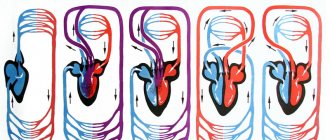Atherosclerosis is a common chronic artery disease in older people. It occurs due to a violation of fat and protein metabolism, as a result of which cholesterol is deposited in the vessels. Plaques close the lumen in the arteries, which leads to their deformation and blockage. Atherosclerosis of blood vessels without treatment leads to coronary heart disease.
Elderly people need help with atherosclerosis. The diagnosis is quite serious, so a person in old age requires appropriate care, regular examinations, and monitoring the intake of necessary medications.
What people are at risk and what triggers the development of this disease?
- Smoking.
- Diabetes.
- Hypertension.
- Passive lifestyle.
- Stress.
Rehabilitation for atherosclerosis
If you do not have time to monitor the health of an elderly person around the clock, we advise you to provide him with proper care and register him in the Parents' Estate nursing home in Irkutsk. Our specialists will be able to provide the necessary comprehensive assistance to people suffering from atherosclerosis and other cardiovascular diseases, and will provide round-the-clock monitoring and careful care for the elderly.
The staff of the boarding house for the elderly in Irkutsk has extensive experience working with pensioners with various diseases. They will be able to help people with atherosclerosis recover, take prescribed medications on time, and attend physical education classes. Rehabilitation after atherosclerosis and exercises for physical therapy are selected for each patient strictly individually. We will be able to provide our patients with the necessary assistance during the rehabilitation period and eliminate the risks of complications. Most often, at the age of 60+, atherosclerosis of the lower extremities develops. The disease leads to vascular inconductivity and tissue necrosis. You can get rid of thrombosis not only with medications, but also with surgery. In our boarding house, nurses provide assistance for atherosclerosis of the lower extremities, as well as for elderly people after surgery.
Nursing care for atherosclerosis
How can our nurses and nurses help a sick elderly person? Competent staff of the boarding house carefully ensure that the patient follows all the recommendations of the attending physician, takes medications on time and reports the first symptoms of illness. Naturally, atherosclerosis has its own peculiarities of nursing care, which our employees are aware of.
Atherosclerosis: causes and prevention
What is this - a disease or a norm?
How does atherosclerotic plaque form? Prevention and treatment of atherosclerosis
What is it - a disease or a norm?
Unfortunately, most people do not attach due importance to the symptoms of the onset and development of atherosclerosis, and know little about the causes of its occurrence, measures for prevention and preservation of vascular health.
Atherosclerosis (more precisely, increased cholesterol in the blood) is one of the main risk factors for cardiovascular diseases. The consequences of atherosclerosis account for approximately half of deaths in most developed countries. It doesn’t hurt to remember this every time you want to eat a fried pie, ham or something “fatty”.
In healthy people, blood flows freely through the arteries to all parts of the body, supplying them with oxygen and other nutrients. With atherosclerosis, plaques form on the inner wall of the arteries, which can lead to complete blockage of the vessel.
How does atherosclerotic plaque form?
The word “atherosclerosis” comes from two ancient Greek words: athere – “mush” and sclerosis – “hard”, “dense”. This reflects the stages of development of an atherosclerotic plaque. There are three main stages of atherosclerotic plaque formation (atherogenesis):
- Formation of lipid (fat) spots and streaks (stage of lipoidosis).
- Formation of fibrous plaque (stage of liposclerosis).
- Formation of complicated atherosclerotic plaque.
Formation of lipid spots and streaks
The initial stage is characterized by the appearance of fatty deposits in the form of spots and stripes on the inner vascular wall of the arteries (arterial intima), which is a barrier between the arterial wall and the blood.
Why does fat deposit on blood vessels occur?
Under certain pathological conditions (trauma, some viral diseases, toxic influences, smoking, alcohol abuse and many others), damage to the integrity of the internal vascular wall
, accompanied by an increase in the permeability of this barrier.
Low-density lipoproteins (LDL - the so-called “bad cholesterol”) penetrate into sites of damage to the inner vascular wall of the arteries and undergo oxidation or glycosylation (modification), which further damages the inner layer of vessel cells.
Our immune system does not ignore this pathological process. Trying to fix everything, monocytes (immune cells) penetrate the vascular wall of the arteries, transform into macrophages, which, with the help of so-called sequencer receptors (“scavenger receptors”), absorb modified LDL and accumulate cholesterol. Macrophages overloaded with fats turn into xanthoma (foam) cells. Some xanthoma cells that have absorbed lipoproteins from the intercellular substance leave the artery wall, thereby preventing the accumulation of fats in it. If the entry of lipoproteins (“bad cholesterol”) into the vascular wall prevails over their removal by macrophages (or other routes), fats accumulate, and ultimately an atherosclerotic plaque is formed. In a growing plaque, some xanthoma (foam) cells die and are destroyed. As a result, a cavity is formed in the center of the plaque, filled with rich fatty masses, which is typical for the later stages of the formation of an atherosclerotic plaque.
Formation of fibrous plaques
As the pathological process progresses, young connective tissue grows in areas of fat deposition, which leads to the formation of fibrous plaques, in the center of which a so-called lipid (fat) core is formed. As the connective tissue matures, a connective tissue framework of the atherosclerotic plaque is formed - a “tyre”, which separates the lipid core from the lumen of the vessel. A typical fibrous plaque is formed, protruding into the lumen of the vessel and disrupting the blood flow in it.
The clinical and prognostic significance of a formed atherosclerotic plaque largely depends on the structure of its fibrous cap and the size of the lipid core. In some cases (including in the relatively early stages of plaque formation), its lipid core is well defined, and the connective tissue capsule is relatively thin and can be easily damaged under the influence of high blood pressure, accelerated blood flow in the artery and other factors. These soft and elastic plaques are sometimes called “yellow plaques.” They, as a rule, slightly narrow the lumen of the vessel, but are associated with a high risk of damage and rupture of the fibrous capsule, that is, with the formation of the so-called “complicated” atherosclerotic plaque.
In other cases (usually in later stages), the fibrous cap is well defined, dense and less susceptible to damage and rupture. Such plaques are called “white”. They often protrude significantly into the lumen of the artery and cause a hemodynamically significant narrowing (by 50% or more of the internal diameter of the artery), leading to disruption of the blood supply to the organ supplied by the artery. In some cases, such plaques may be complicated by the occurrence of a mural thrombus.
The first two stages of atherogenesis culminate in the formation of an uncomplicated atherosclerotic plaque. The progression of the atheromatous process leads to the formation of a “complicated” atherosclerotic plaque, resulting in the formation of a wall thrombus, which can lead to a sudden and severe limitation of blood flow in the artery.
Formation of a “complicated” plaque
This stage of atheromatosis is characterized by a significant increase in the lipid core (up to 30% or more of the total volume of the plaque), the occurrence of hemorrhages in the plaque, thinning of its fibrous capsule and destruction of the cap with the formation of cracks, ruptures and atheromatous ulcers.
Particles of collapsing plaque falling into the lumen of the vessels can become a source of embolism - a condition in which the lumens of blood vessels are blocked by an embolus, that is, a particle brought with the bloodstream (a detached blood clot, fat from damaged tissue, etc.). The atheromatous ulcer itself serves as the basis for the formation of blood clots. The final stage of atherosclerosis is atherocalcinosis, the deposition of calcium salts in atherosclerotic masses.
The main consequence of the formation of a “complicated” atherosclerotic plaque is the formation of a parietal thrombus, which suddenly and sharply restricts blood flow in the artery. In most cases, it is during this period that clinical manifestations of exacerbation of the disease occur, corresponding to the localization of the atherosclerotic plaque (unstable angina, myocardial infarction, ischemic stroke, etc.).
Prevention and treatment of atherosclerosis
Atherosclerosis occurs in everyone. The only difference is in the degree and speed of its development, which is largely determined by people’s lifestyle, bad habits, and hereditary factors. This disease develops unnoticed, affecting more and more arteries over the years.
Until recently, atherosclerosis was considered a steadily progressive disease. In recent years, evidence has emerged that the development of atherosclerosis can be slowed or stopped.
This result can be achieved by regularly taking certain medications and changing your lifestyle and behavioral habits.
.
It is necessary to begin measures to prevent atherosclerosis as early as possible, without waiting for clinical manifestations of the disease.
The main recommendation is lifestyle changes. In other words, if there is a high risk of atherosclerosis, it is necessary to start leading a healthy lifestyle, which includes:
- to give up smoking;
- sufficient physical activity;
- normalization of body weight;
- maintaining normal blood pressure;
- change in nutritional pattern. Specific recommendations are displayed in the table: Table 1. Rules for the prevention of atherosclerosis
| AVOID | TRY |
|
|
|
|
|
|
|
|
|
|
For the development of atherosclerosis, the most important factor is elevated cholesterol levels in the blood, so the goal of treating atherosclerosis is to normalize cholesterol levels.
If, as a result of dietary changes (cholesterol-lowering diet) and lifestyle adjustments, it is not possible to achieve the desired cholesterol level, the doctor prescribes medications.
The key to success in the treatment of atherosclerosis is following the doctor’s instructions.
The reward for your efforts to change your lifestyle and take medications prescribed by your doctor is INCREASED HEALTHY LIFESPAN. Share on social media networks
What does caring for a patient with atherosclerosis include?
- Assistance with hygiene procedures: washing, brushing teeth, bathing, cutting hair and nails.
- If the patient is a bedridden patient, special care is required, including feeding, daily change of linen, diapers, ducks, cleanliness, prevention of bedsores and much more.
- Ironing, washing and regular change of linen and clothes.
- Cleaning and airing rooms.
- Accompaniment for a walk.
- Preparing for the examination.
- Health monitoring.
When caring for a patient with atherosclerosis, psychological assistance and support from boarding house workers is very important. Care, attention and a polite, considerate attitude work wonders. Patients recover quickly, their condition does not worsen, but goes into remission, and their mood returns to normal. Nurses must explain to the patient why it is so important to follow the doctor’s instructions and adhere to the diet. This attitude is the best way to promote recovery.
Classification of forms of the disease
Atherosclerosis is a systemic disease that affects all arteries, however, depending on the predominance of the severity of atherosclerosis in a particular group of vessels, it is divided into:
- atherosclerosis of the coronary arteries (causing coronary heart disease and angina, which can result in myocardial infarction),
- atherosclerosis of the brachiocephalic arteries (causing chronic insufficiency of cerebral blood flow, which can result in a stroke),
- atherosclerosis of the aorta, iliac arteries and arteries of the lower extremities (causing intermittent claudication, which can result in gangrene of the lower extremity or fingers),
- atherosclerosis of the visceral branches of the aorta (impaired blood flow in the internal organs, which can result in infarction of the intestine, kidney, etc.),
- multifocal atherosclerosis (damage to several of the above groups of vessels).
What are the main signs of atherosclerosis?
The disease develops gradually, and at the initial stage it can be confused with the consequences of severe fatigue. A person gets tired quickly, periodically hears tinnitus, and dizziness and headaches may also occur, which gradually disappear. Symptoms intensify as atherosclerotic plaques increase, preventing blood from flowing through the vessels to the brain, internal organs, upper and lower extremities. At the second stage, the patient faces:
1. Insomnia. 2. Memory impairment. 3. Regular migraines. 4. Convulsive syndrome. 5. Substernal pain (with damage to the aorta). 6. Difficulty breathing. 7. Significant decrease in performance. 8. Swelling, numbness of the hands and feet. 9. Stable high blood pressure. 10. Pain in the spine.
If nothing is done, then the old man may develop dementia, spatial and/or temporal disorientation against the background of atherosclerosis. In this state, a person is absolutely helpless and needs constant care and attention. Timely consultation with doctors and monitoring your well-being will help you avoid complications such as stroke, heart attack, and chronic renal failure.
Causes and risk factors
Despite numerous studies, doctors cannot say for sure what provokes atherosclerosis, but there is a direct relationship between a person’s age and the likelihood of getting sick. Risk factors also include:
• unfavorable family history; • prolonged smoking and alcohol abuse; • metabolic disorders (diabetes mellitus, thyroid diseases, etc.); • excess body weight; • sedentary lifestyle; • high blood pressure; • frequent stressful situations, nervous overload; • pathology of the aorta; • gout; • other disorders of the cardiovascular system.










